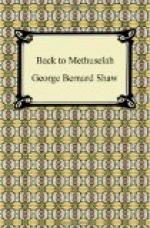Summer afternoon in the year 31,920 A.D. A sunlit glade at the southern foot of a thickly wooded hill. On the west side of it, the steps and columned porch of a dainty little classic temple. Between it and the hill, a rising path to the wooded heights begins with rough steps of stones in the moss. On the opposite side, a grove. In the middle of the glade, an altar in the form of a low marble table as long as a man, set parallel to the temple steps and pointing to the hill. Curved marble benches radiate from it into the foreground; but they are not joined to it: there is plenty of space to pass between the altar and the benches.
A dance of youths and maidens is in progress. The music is provided by a few fluteplayers seated carelessly on the steps of the temple. There are no children; and none of the dancers seems younger than eighteen. Some of the youths have beards. Their dress, like the architecture of the theatre and the design of the altar and curved seats, resembles Grecian of the fourth century B.C., freely handled. They move with perfect balance and remarkable grace, racing through a figure like a farandole. They neither romp nor hug in our manner.
At the first full close they clap their hands to stop the musicians, who recommence with a saraband, during which a strange figure appears on the path beyond the temple. He is deep in thought, with his eyes closed and his feet feeling automatically for the rough irregular steps as he slowly descends them. Except for a sort of linen kilt consisting mainly of a girdle carrying a sporran and a few minor pockets, he is naked. In physical hardihood and uprightness he seems to be in the prime of life; and his eyes and mouth shew no signs of age; but his face, though fully and firmly fleshed, bears a network of lines, varying from furrows to hairbreadth reticulations, as if Time had worked over every inch of it incessantly through whole geologic periods. His head is finely domed and utterly bald. Except for his eyelashes he is quite hairless. He is unconscious of his surroundings, and walks right into one of the dancing couples, separating them. He wakes up and stares about him. The couple stop indignantly. The rest stop. The music stops. The youth whom he has jostled accosts him without malice, but without anything that we should call manners._
THE YOUTH. Now, then, ancient sleepwalker, why don’t you keep your eyes open and mind where you are going?
THE ANCIENT [mild, bland, and indulgent] I did not know there was a nursery here, or I should not have turned my face in this direction. Such accidents cannot always be avoided. Go on with your play: I will turn back.
THE YOUTH. Why not stay with us and enjoy life for once in a way? We will teach you to dance.
THE ANCIENT. No, thank you. I danced when I was a child like you. Dancing is a very crude attempt to get into the rhythm of life. It would be painful to me to go back from that rhythm to your babyish gambols: in fact I could not do it if I tried. But at your age it is pleasant: and I am sorry I disturbed you.




